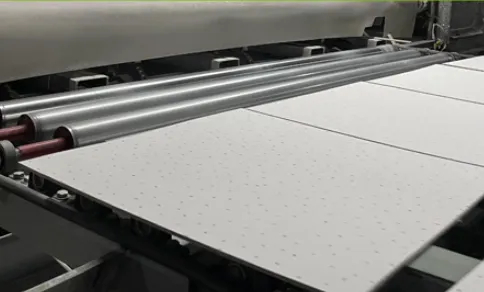Nov . 18, 2024 00:34 Back to list
mineral fiber acoustic ceiling
The Advantages of Mineral Fiber Acoustic Ceilings
In the realm of modern architecture and interior design, the choice of ceiling materials plays a pivotal role in both functionality and aesthetics. One popular option that has gained significant traction over the years is mineral fiber acoustic ceilings. These ceilings offer a unique combination of sound absorption, thermal insulation, and design flexibility, making them a preferred choice for a variety of applications, from commercial buildings to residential spaces.
What is Mineral Fiber?
Mineral fiber is a composite material primarily composed of natural minerals, such as gypsum, along with various synthetic fibers. This combination results in a lightweight yet durable material that can be shaped and molded into different formats, providing multiple design options. Mineral fiber ceilings are often manufactured in tiles or panels, which can be easily installed and fit into standard grid systems.
Sound Absorption Properties
One of the standout features of mineral fiber acoustic ceilings is their superior sound-absorbing properties. In environments such as offices, schools, and hospitals, controlling noise levels is crucial for creating comfortable and productive spaces. Mineral fiber ceilings help to reduce the echo and reverberation of sound, ensuring that conversations remain private and that overall noise levels are minimized. This makes them particularly valuable in open-plan offices, where distractions can hinder concentration.
The acoustical performance of mineral fiber ceilings is typically measured by the Noise Reduction Coefficient (NRC). Products with a higher NRC value indicate better sound absorption capabilities. Many mineral fiber ceilings boast NRC ratings of 0.70 and above, making them highly effective at maintaining a quiet environment.
Thermal Insulation
mineral fiber acoustic ceiling

In addition to noise control, mineral fiber acoustic ceilings also provide thermal insulation properties. They can help to maintain a comfortable indoor temperature by reducing heat loss in winter and keeping spaces cooler in summer. This energy efficiency not only promotes environmental sustainability but also results in lower heating and cooling costs, making mineral fiber ceilings a cost-effective choice in the long run.
Design Flexibility and Aesthetics
Another advantage of mineral fiber acoustic ceilings is their design flexibility. Available in various textures, styles, and colors, these ceilings can be tailored to suit almost any design aesthetic. Whether it’s for a sleek modern office, a warm and inviting café, or a sophisticated retail space, mineral fiber ceilings can enhance the overall visual appeal of a room. The surface can be painted or coated to match the interior design scheme, providing endless possibilities for customization.
Easy Installation and Maintenance
Installation is another area where mineral fiber acoustic ceilings excel. The lightweight nature of the tiles makes them easy to handle and install, often requiring less labor time compared to heavier materials. Additionally, these ceilings are designed for easy access to plumbing and electrical systems, allowing for straightforward modifications or repairs.
Maintenance is also manageable; mineral fiber ceilings can be effortlessly cleaned with a damp cloth or a gentle vacuum, and many products are treated to resist stains and sagging over time. This ensures that the ceilings will retain their aesthetic appeal and performance characteristics throughout their lifespan.
Conclusion
In conclusion, mineral fiber acoustic ceilings are an outstanding option for those looking to combine functionality with style. Their excellent sound absorption, thermal insulation capabilities, aesthetic flexibility, ease of installation, and low maintenance requirements make them ideal for a variety of settings. As building designs increasingly prioritize acoustic comfort and energy efficiency, the appeal of mineral fiber acoustic ceilings is likely to continue growing, making them a cornerstone in the future of architectural design and interior space planning. Whether you are renovating an existing space or embarking on a new construction project, integrating mineral fiber acoustic ceilings could be a step towards achieving a quieter, more comfortable environment.
-
Quality Ceiling Trap Doors & Access Panels | Easy & Secure AccessNewsAug.30,2025
-
Durable Ceiling T Grid Systems | Easy InstallationNewsAug.29,2025
-
PVC Gypsum Ceiling: Durable, Laminated Tiles for Modern SpacesNewsAug.28,2025
-
Pvc Gypsum Ceiling Is DurableNewsAug.21,2025
-
Mineral Fiber Board Is DurableNewsAug.21,2025
-
Ceiling Tile Clip Reusable DesignNewsAug.21,2025







